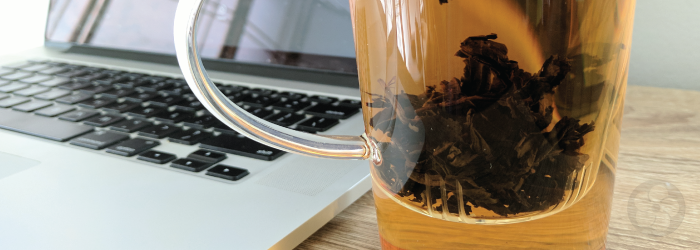How Tea Can Boost Productivity

In today’s fast paced world, it can seem like there are never enough hours in the day. There is no shortage of tips and tricks designed to increase productivity, and make the best use of each available moment.
Tea is a commonly lauded productivity tool, drawing attention mostly as an alternative to coffee. But the reasons behind these recommendations are often poorly explained. Given the proliferation of dubious claims regarding medicinal uses for tea, it is reasonable to be skeptical.
Fortunately, this particular claim is perfectly valid. A daily brew is likely to decrease fatigue, while improving focus. Here are a few ways that tea can help you be more productive throughout the day.
Caffeine & Theanine
Tea is often a recommended alternative for caffeine addicts trying to cut down on coffee. With levels of caffeine at less than half that in a standard cup of drip coffee, it can be an effective way to gradually reduce caffeine intake, along with jitters and energy crashes. But this is only one way in which the effects of caffeine differ between the two beverages.
Notably, tea also contains an amino acid called L-theanine, which works in concert with caffeine. Caffeine works by blocking the transfer of adenosine, a chemical that signals fatigue in the brain. When the transfer is blocked, so is the feeling of being tired. In contrast, L-theanine stimulates the production of dopamine and serotonin, which cause feelings of happiness and well-being. Together with the lower dose of caffeine typically found in a cup of tea, the presence of L-theanine helps induce a stable energy boost, without the jittery hype or exhausted crash felt after a cup of coffee.
Flavorful Hydration
One of the most popular (and effective) productivity tips is to stay hydrated. But drinking enough water can be surprisingly difficult, especially if the tap water where you are doesn’t taste that great. Along with its widely touted nutritional benefits, tea is first and foremost a method of enhancing the flavor of water.
This was one of the primary reasons behind tea’s initial worldwide popularity. If the available drinking water was not palatable, it could be much improved if it was boiled (and thereby sterilized), and then flavored with some potent tea leaves. Over the centuries, the art of cultivating and crafting tea has refined a varied range of complex flavors, just as in winemaking.
Given the huge variety in styles and flavors, there is sure to be a tea out there that appeals to your palate. Finding a favorite tea can make your daily water intake feel like a treat, rather than a chore.
Brewing Breaks
It has been repeatedly proven that regular breaks are key to maximizing productivity and reducing burnout. Regular short breaks are the key to productivity techniques like the Pomodoro Method, which advocates a 5 minute break after every 25 minutes of work. While a 12 ounce mug of tea every 30 minutes would probably send you running for the restroom, the Chinese brewing method of gong fu cha is perfectly suited to this type of scheduling.
Though it is sometimes called the “Chinese tea ceremony” and can conjure images of involved brewing techniques, gong fu cha does not complicate the steeping process. The three basic steps of brewing (add hot water, steep, remove leaves) simply take place in a smaller vessel - usually holding no more than 6 to 8 ounces of water. The leaves are left in the water for no more than 1-2 minutes, before the brewed tea is poured off into a cup. Subsequently, more water can be added, extracting flavor from the expanding leaves for at least 3 or 4 infusions.
Short, repeated infusions can be spaced out throughout the day, offering opportunities for refreshing breaks. As a bonus, multiple brews of the same leaves will have the added effect of spacing out caffeine intake throughout the day, contributing to a balanced energy level, without crashes.
Tea can be a valuable asset in your productivity toolbox, whether as an alternative to other caffeinated drinks like coffee or soda, or as a novel addition to your daily routine.
Get started with these three easy brewing methods to make tea an effortless and enjoyable part of your day.
Sign up for our newsletter to get blog updates in your inbox!






Comments on this post (0)